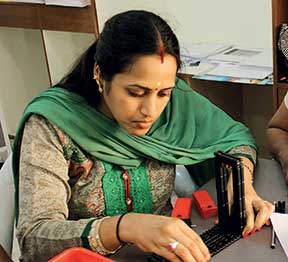Padmaja Narsipur
This article discusses why Continuing Professional Development for teachers is critical for the success of students and lists some ways teachers can explore CPD.
 The Right to Education (RTE) Act 2009 recommends that schools work 45 hours per week. The CBSE is mulling over a proposal to run secondary and senior secondary schools for 6 hours 10 minutes a day, 6 days a week to meet RTE norms1. Teachers would teach 30 teaching hours per week, and spend 80 minutes every day (an additional 8 hours per week) after school for “…planning, checking, preparation, follow up work, and so on.”
The Right to Education (RTE) Act 2009 recommends that schools work 45 hours per week. The CBSE is mulling over a proposal to run secondary and senior secondary schools for 6 hours 10 minutes a day, 6 days a week to meet RTE norms1. Teachers would teach 30 teaching hours per week, and spend 80 minutes every day (an additional 8 hours per week) after school for “…planning, checking, preparation, follow up work, and so on.”
The National Curriculum Framework (NCF) 2005 recommends an overhaul of the teacher education process, and supports time for reflection, self and peer evaluation, and most importantly for In-Service Training (INSET) and Continuous Professional Development (CPD) for teachers.
However, the reality is that very little time is spent on these after the 1200+ teaching hours each teacher puts in during an academic year. Without CPD, how can teachers learn to cope with the needs of 21st century learners?
The 21st century teacher: mentor, facilitator, guide
As classrooms transform into 21st century learning spaces where children use digital tools, internet-enabled computers and practical learning aids, and learning becomes more experiential, the teacher gets to mingle with the students, moving from group to group, facilitating thought, mentoring, and helping students.
In the process, she is not overly concerned about rigid discipline, but allows some moments of chaos, interruption and new directions to remain in the flow. She is no longer a lone transmitter of information, but a co-learner and facilitator.
 Tips for continuing professional development
Tips for continuing professional development
While most professional courses demand four or more years of rigorous study, one of the most important professions – teaching – requires much less. Most teachers learn on the job, making CPD all the more critical.
However, undertaking CPD in the hurly-burly of school life and convincing school management of its necessity is quite difficult. A study2 commissioned by the British Council found that in India, “It is very common to see CPD equated with in-service training (INSET) programmes… one-off, isolated, short-term and infrequent training events.”
The NCF, while recommending multi-modal training programs for teacher education, acknowledges that teachers remain isolated from institutions of higher learning, stating that, “… existing [teacher] education programmes neither accommodate emerging ideas in context and pedagogy nor address the issue of linkages between school and society.”3
This is why teachers themselves must actively seek CPD opportunities presented to them via various sources – to maintain their currency and keep their professional skills updated, even amidst hectic school days and heavy workloads.
Here are some pointers for teachers to stay relevant and enrich their careers in the 21st century:
Go digital – Have you wondered if there is a better way to use the all-pervasive technology to involve today’s “information-rich” students rather than just showing them images on the projector?
Teachers must immerse themselves in technology if they want to offer novel, immersive learning methods to students. Digital content consumption is just the first step towards a technology-enabled education. Teachers must learn to create digital content and participate in the vast online knowledge society. They can then help students do the same responsibly and thoughtfully.
 To start with, familiarize yourself with social media, wikis, and blogs. Why not blog (whenever you can) about your teaching experiences in the classroom? Blogs allow for reflection on what we do everyday and give us a big picture perspective on what works and what doesn’t in the classroom.
To start with, familiarize yourself with social media, wikis, and blogs. Why not blog (whenever you can) about your teaching experiences in the classroom? Blogs allow for reflection on what we do everyday and give us a big picture perspective on what works and what doesn’t in the classroom.
The Internet offers other amazing teaching aids such as infographics, images and video content, besides critical articles, studies and information on virtually any topic.
Teacher Development Groups – Join a teacher development group at your school or in your city. A support group that offers informed opinion and critiques one’s work can be invaluable. Many teachers find mentors in such groups. Mentoring junior teachers can enrich your own growth.
Teacher Development Groups are ideal forums to present successes and learn from failures. They offer networking opportunities, whether within the school, in the larger community outside, those supported by the education boards, or communities online. “The matrix of networking was an important aspect of growth as we realized that exposure to a variety of ideas shapes the thought-processes of teachers,” opines Ms. Jayagowri Shivakumar, in her paper on “Teacher Development Groups: Nurturing Continuing Professional Development”4.
A Google search throws up useful website links of many teacher groups. http://www.teachersofindia.org is one such Indian resource.
Seek out PD opportunities through school programs – Progressive schools have recognized that continuous teacher training is essential and are fitting in regular training hours for teachers in the calendar similar to corporates. The transformation is being felt in many schools as newly empowered teachers reach out and change their classrooms and students.
Schools have found that getting their own teachers trained to deliver learning programs reap more long term benefits, rather than asking for a ‘resource person’ from the vendor. Teachers enhance their knowledge base from such on-the-job training. The school benefits with better integration.
Creya Learning is one of the pioneers in training teachers as part of their flagship in-school program XEL. Creya has a thoroughly researched and comprehensively designed professional development program for the teachers of their partner schools. XEL equips students with the skills, competencies and literacies necessary for the 21st century.
 The XEL PD program for teachers runs through every year of the contract with the school (typically four years). It offers contextual training for teachers; practical exposure to engaging children through the construct of ‘Learning Studios’, peppered with periodic interventions and reflections to translate the learning to everyday classrooms. The use of inquiry, constructivism, project-based learning, collaborative study, STEM education and other such methods to improve learning outcomes become a norm for the teachers.
The XEL PD program for teachers runs through every year of the contract with the school (typically four years). It offers contextual training for teachers; practical exposure to engaging children through the construct of ‘Learning Studios’, peppered with periodic interventions and reflections to translate the learning to everyday classrooms. The use of inquiry, constructivism, project-based learning, collaborative study, STEM education and other such methods to improve learning outcomes become a norm for the teachers.
Learn relevant new skills – “21st century skills” – learning and innovation skills such as communication, collaboration, creativity, and critical thinking (the 4Cs) and others – are as vital for teachers as they are for students. If teachers don’t recognize what the skills are and how to integrate them into the school curriculum, how can they teach children?
Besides the 4Cs, the list includes information media and ICT literacy, and life and career skills such as flexibility and adaptability. These are vital for our students’ future success in life and work in the 21st century. Teachers must equip themselves with these skills and facilitate the environment and learning for children to acquire them.
Start a portfolio – A portfolio is vital for every teacher’s CPD. Besides recording all relevant personal information such as qualifications, employment history and CV, it may contain records and reflective commentaries of CPD activities, plans for development, self-evaluation of professional competencies and illustrations of skills and abilities. It is a handy resource when talking to mentors or school management, and a record of your personal CPD journey and growth as a teacher.
Maintaining a portfolio is quite easy with the Internet. Dr. Helen Barrett, a researcher in electronic portfolios for K-12 educators who writes on http://electronicportfolios.org recommends using Google Apps for interactive e-portfolios, Google Docs for a digital archive, Blogger for reflective journals and Google Sites or SlideShare for presentations.
CPD online – The Internet offers many structured CPD programs and certifications that can be done at one’s own time and pace, without missing school – particularly attractive for school management, who may hesitate to let teachers go away for CPD during the academic year.
Online CPD programs can be highly targeted and subject specific. For instance, the Royal Society for Chemistry in London offers online courses in developing expertise in teaching chemistry (https://www.rsc.org/cpd/teachers/online). Education portal Coursera (http://www.coursera.org) offers free teacher CPD courses from 34 universities and institutes worldwide.
Networking opportunities – The British Council study states that “…because of the restricted view of CPD as INSET, only official INSET programmes receive recognition and support, while other forms of CPD activities such as attending conferences, acquiring additional qualifications or forming learning communities are… not recognized”. This attitude must change. Many education and learning conferences, conventions and meetings are being held in our metros that focus on the teaching profession and offer seminars, panel discussions and paper presentations on the latest developments in the field.
Talk to your school’s management about attending such events, where you can learn about the latest developments, skills and pedagogies, and network with other professionals.
Summary
Being a teacher is one of the best services one can render society, as a teacher launches a thousand lives, and “…affects eternity” in the words of Henry Brooks Adams. Every teacher must make the (superhuman) effort to keep learning, stay relevant and continuously improve himself/herself. The key to building our country’s future is in empowering our teachers.
References
- “From 2015, CBSE schools may have 6 functioning days”, http://articles.economictimes.indiatimes.com/2013-12-03/news/44710338_1_cbse-schools-school-hours-planning, Dec 2013.
- “Continuing Professional Development: Lessons from India”, Edited by Rod Bolitho and Amol Padwad, British Council, 2013.
- National Curriculum Framework 2005, Page 107, http://www.ncert.nic.in/rightside/links/pdf/framework/english/nf2005.pdf.
- British Council Study.
The author works with pioneering education providers such as Creya Learning to evangelise the need to change the way our children learn. Teachers or schools who wish to start Teacher Development Groups may contact her at padmaja.narsipur@gmail.com.
